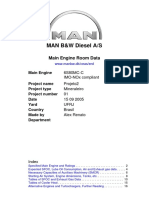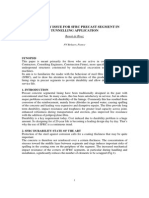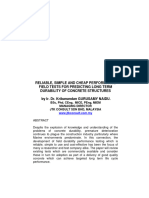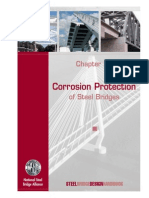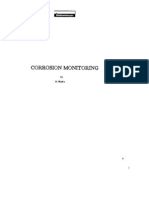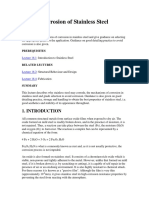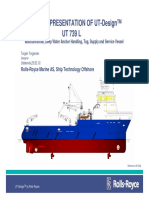IACS Rec.96
IACS Rec.96
Uploaded by
Cinthia Lidia Hidrogo PaulinoCopyright:
Available Formats
IACS Rec.96
IACS Rec.96
Uploaded by
Cinthia Lidia Hidrogo PaulinoOriginal Description:
Copyright
Available Formats
Share this document
Did you find this document useful?
Is this content inappropriate?
Copyright:
Available Formats
IACS Rec.96
IACS Rec.96
Uploaded by
Cinthia Lidia Hidrogo PaulinoCopyright:
Available Formats
DOUBLEHULLOILTANKERS:GUIDELINESFORSURVEYS,ASSESSMENTANDREPAIROFHULLSTRUCTURES 3 TECHNICAL BACKGROUND FOR SURVEYS
For locations where cracking is due to low-cycle fatigue, the use of HTS in local details
may be very beneficial for the fatigue strength. This is the case for areas, which are
subject to large static stress variations due to loading and unloading, such as the
connection between the hopper plating and the double bottom plating. For such
locations, local details with HTS will experience less plastic strains, and the low cycle
fatigue strength therefore be increased compared with mild steel details. Nevertheless it
should be checked whether wave induced loads are marginal or not.
3.4.4 Typical Corrosion Patterns
In addition to being familiar with typical structural defects likely to be encountered during
a survey, it is necessary to be aware of the various forms and possible locations of
corrosion that may occur to the structural members on decks and in tanks.
The main types of corrosion patterns, which may be identified, include the following:
(a) General Corrosion
General corrosion appears as non-protective, friable rust, which can occur uniformly on
tank internal surfaces that are uncoated. The rust scale continually breaks off, exposing
fresh metal to corrosive attack. Thickness loss cannot usually be judged visually until
excessive loss has occurred. Failure to remove mill scale during construction of the ship
can accelerate corrosion experienced in service. Severe general corrosion in all types of
ships, usually characterized by heavy scale accumulation, can lead to extensive steel
renewals.
(b) Grooving Corrosion
Grooving corrosion is often found in or beside welds, especially in the heat affected zone.
This corrosion is sometimes referred to as 'inline pitting attack' and can also occur on
vertical members and flush sides of bulkheads in way of flexing. The corrosion is caused
by the galvanic current generated from the difference of the metallographic structure
between the heat affected zone and base metal. Coating of the welds is generally less
effective compared to other areas due to roughness of the surface, which exacerbates
the corrosion. Grooving corrosion may lead to stress concentrations and further
accelerate the corrosion process. Grooving corrosion may be found in the base material
where coating has been scratched or the metal itself has been mechanically damaged.
An example of grooving corrosion is shown in Figure 8.
INTERNATIONAL ASSOCIATION OF CLASSIFICATION SOCIETIES 3 TECHNICAL BACKGROUND FOR SURVEYS
18
DOUBLEHULLOILTANKERS:GUIDELINESFORSURVEYS,ASSESSMENTANDREPAIROFHULLSTRUCTURES 3 TECHNICAL BACKGROUND FOR SURVEYS
Groove Groove
breadth breadth
Attached plating
Groove breadth Groove breadth
Flatbar stiffener
Figure 8 Grooving Corrosion
(c ) Pitting Corrosion
Pitting corrosion is a localized corrosion often found in the inner bottom plating or on
horizontal surfaces in cargo oil tanks and in the bottom plating of ballast tanks. Pitting
corrosion is normally initiated due to local breakdown of coating. For coated surfaces the
attack produces deep and relatively small diameter pits that can lead to hull penetration
in isolated random places in the tank.
Pitting of uncoated tanks, as it progresses, forms shallow but very wide scabby patches
(e.g. 300 mm diameter); the appearance resembles a condition of general corrosion.
Severe pitting of uncoated tanks can affect the strength of the structure and lead to
extensive steel renewals.
Once pitting corrosion starts, it is exacerbated by the galvanic current between the pit
and other metal.
Erosion which is caused by the wearing effect of flowing liquid and abrasion which is
caused by mechanical actions may also be responsible for material wastage.
(d) Edge Corrosion
Edge corrosion is defined as local corrosion at the free edges of plates, stiffeners,
primary support members and around openings. An example of edge corrosion is shown
in Figure 9.
INTERNATIONAL ASSOCIATION OF CLASSIFICATION SOCIETIES 3 TECHNICAL BACKGROUND FOR SURVEYS
19
DOUBLEHULLOILTANKERS:GUIDELINESFORSURVEYS,ASSESSMENTANDREPAIROFHULLSTRUCTURES 3 TECHNICAL BACKGROUND FOR SURVEYS
Figure 9 Edge Corrosion
3.4.5 Factors Influencing Corrosion
When corrosion problems occur it is important to have some understanding of the
possible contributing factors to the corrosion so that remedial action taken will minimize
the possibility of future repetition. The significance of each of these factors will vary
depending upon the tank service. Similarly, for ballast tanks the effectiveness of the
protection system and high humidity could be major factors. For cargo only tanks the
method and frequency of tank washing and the sulphur content of the cargo could be
factors of particular significance.
The following is a list of possible factors, which might be relevant in evaluating corrosion
patterns being experienced:
(a) Frequency of Tank Washings
Increased frequency of tank washings can increase the corrosion rate of tanks. For
uncoated tanks, it is often possible to see lines of corrosion in way of the direct
impingement paths of the crude oil washing machines.
(b) Composition and Properties of Cargo
Carriage of crude oil can result in the tank surfaces in contact with the cargo being
coated with a "waxy" or "oily" film, which is retained after cargo discharge. This film
can reduce corrosion. Less viscous cargoes such as gasoline do not leave behind a
similar film.
Carriage of crude oil that has high sulphur content can lead to high rates for general
corrosion and tank bottom pitting corrosion. By reacting with water many sulphur
compounds can form acids, which are very corrosive. This will often mean that water
bottom dropping out of the cargo will be acidic and corrosive.
Carriage of cargoes with high water content can increase corrosion rates.
Carriage of cargoes with high oxygen content (e.g. gasoline) can lead to high
INTERNATIONAL ASSOCIATION OF CLASSIFICATION SOCIETIES 3 TECHNICAL BACKGROUND FOR SURVEYS
20
DOUBLEHULLOILTANKERS:GUIDELINESFORSURVEYS,ASSESSMENTANDREPAIROFHULLSTRUCTURES 3 TECHNICAL BACKGROUND FOR SURVEYS
corrosion rates.
Carriage of cargoes with low pH values (acidic) can lead to high corrosion rates.
(c) Time in Ballast
For ballast tanks where the coating has started to fail, corrosion increases with the
time in ballast.
(d) Microbial Induced Corrosion
Microbial influenced corrosion is the combination of the normal galvanic corrosion
processes and the microbial metabolism. The presence of microbial metabolites
generates corrosive environments, which promote the normal galvanic corrosion.
For tanks that remain filled with contaminated ballast water for a long time, the
potential for microbial induced corrosion, in the form of grooving or pitting, is
increased. The microbes could penetrate pinholes and accelerate the coating
breakdown and corrosion in the infected areas. Proper procedures, such as flushing
with clean (open sea) salt water, will help reduce the potential for this type of
corrosion.
Cargo oil often contains residual water, which may contain microbes leading to
microbial induced corrosion attacks in the tank bottom or other locations where the
water may collect.
Biocide shock treatment to exterminate the microbes is a method that could be used
in cargo and ballast tanks. In addition clean water flushing at regular intervals will help
reduce the potential of microbial induced corrosion. Proper maintenance of coating
integrity, or blasting and coating the uncoated surfaces, would be an effective method
to deal with microbial induced corrosion.
(e) Humidity of Empty Tank
Empty tanks, e.g. segregated ballast tanks during laden voyages, can have high humidity
and are thus susceptible to general atmospheric corrosion, especially if corrosion control
is by anodes which are ineffective during these periods.
During prolonged periods, when the tanks are left empty, such as lay-ups, maintenance
of low humidity atmosphere in the tanks should be considered to minimise corrosion.
(f) Temperature of Cargo in Adjacent Bunker or Cargo Tanks
Carriage of heated cargoes may lead to increased general corrosion rates at the ballast
tank side of a heated cargo tank/unladen ballast tank bulkhead. This may also apply for
tanks adjacent to heated bunker tanks.
INTERNATIONAL ASSOCIATION OF CLASSIFICATION SOCIETIES 3 TECHNICAL BACKGROUND FOR SURVEYS
21
DOUBLEHULLOILTANKERS:GUIDELINESFORSURVEYS,ASSESSMENTANDREPAIROFHULLSTRUCTURES 3 TECHNICAL BACKGROUND FOR SURVEYS
(g) Coating Breakdown
Intact coatings prevent corrosion of the steel surface.
However:
A local absence of coating (due to coating depletion, deterioration, damage, etc.) can
result in corrosion rates similar or greater than those of unprotected steel.
Holidays or localized breakdown in coating can lead to pitting corrosion rates higher
than for unprotected steel.
Periodic surveys at appropriate intervals and repair of coating as required are effective in
minimising corrosion damage.
(h) Locations and Density of Anodes
Anodes immersed in bottom water can afford protection against bottom corrosion.
Anodes are not effective in reducing underdeck corrosion rates.
Properly designed systems with high current densities may afford greater protection
against corrosion.
Electrical isolation or coatings, oily films, etc., on anodes can make anodes
inoperative; abnormally low wastage rates of anodes may indicate this condition.
(i) Structural Design of Tank
High velocity drainage effects can lead to increased erosion in the vicinity of cut-outs
and some other structural details for uncoated surfaces.
Horizontal internals and some details can trap water and lead to higher corrosion
rates for uncoated surfaces.
Less rigid designs, such as decreased scantlings and increased stiffener spacing,
may lead to increased corrosion due to flexure effects, causing shedding of scale or
loss of coating.
Sloping tank bottoms (e.g. as with double bottom tanks) to facilitate drainage may
reduce bottom corrosion by permitting full stripping of bottom waters.
(j) Gas Inerting
Decreased oxygen content of ullage due to gas inerting may reduce corrosion of
overhead surfaces.
Sulphur oxides from flue gas inerting can lead to accelerated corrosion due to
formation of corrosive sulphuric acid.
(k) Navigational Route
Solar heating of one side of a ship due to the navigational route can lead to increased
corrosion of affected wing tanks.
Anodes used to protect ballast tanks on voyages of short duration may not be
effective due to insufficient anode polarisation period when high corrosion may occur.
INTERNATIONAL ASSOCIATION OF CLASSIFICATION SOCIETIES 3 TECHNICAL BACKGROUND FOR SURVEYS
22
DOUBLEHULLOILTANKERS:GUIDELINESFORSURVEYS,ASSESSMENTANDREPAIROFHULLSTRUCTURES 3 TECHNICAL BACKGROUND FOR SURVEYS
(l) Accelerated structural corrosion in water ballast and cargo tanks
A limited but significant number of double hull tankers have been found to be suffering
from accelerated corrosion in areas of their cargo and ballast tanks. It is now generally
agreed that the “thermos bottle effect”, in which heated cargoes retain their loading
temperatures for much longer periods, promotes an environment within the cargo and
ballast tanks that is more aggressive from the viewpoint of corrosion (as temperatures
rise, corrosion activity increases - warm humid salt laden atmospheres in ballast tanks,
acidic humid conditions in upper cargo tank vapour spaces and warm water and steel
eating microbes on cargo tank bottom areas - all factors which promote corrosion).
If corrosion remains undetected during surveys, loss of tank integrity and oil leakage into
the double hull spaces may occur (increased pollution and explosion risk). In the worst
cases, corrosion can lead to a major structural failure of the hull.
3.4.6 Items for Special Attention of the Surveyor
Taking into account all the possible factors, which might be relevant to a particular tank,
the Surveyor should pay special attention to the following areas when looking for signs of
serious corrosion:
Horizontal surfaces such as bottom plating, face plates and stringers, particularly
towards the after end of the structural element. The wastage may take the form of
general corrosion or pitting. Accelerated local corrosion often occurs at the after bays
and particularly in way of suctions.
Deck heads and ullage spaces in uncoated ballast or cargo/ballast tanks (where
anodes may not be effective) or non-inerted cargo tanks.
Structure in way of lightening holes or cut-outs where accelerated corrosion may be
experienced due to erosion caused by local drainage and flow patterns. Grooving
may also take place on both horizontal and vertical surfaces.
Areas in way of stress concentrations such as at toes of brackets, ends of stiffeners
and around openings.
Surfaces close to high pressure washing units where localised wastage may occur
due to direct jet impingement.
Bulkhead surfaces in ballast tanks adjacent to heated cargo or bunkers.
Areas in way of local coating breakdown.
One of the most effective means for preventing corrosion is to protect the hull
structure with an efficient coating system. In double hulled tankers, the spaces most
at risk from the effects of corrosion are the seawater ballast tanks and the underdeck
structure and bottom areas within the cargo oil tanks.
3.4.7 Corrosion Trends in Tank Spaces
Depending on the tank function and location in the tank, some structural components are
more susceptible to corrosion than others.
The following are some phenomena of corrosion observed in each type of tank space:
INTERNATIONAL ASSOCIATION OF CLASSIFICATION SOCIETIES 3 TECHNICAL BACKGROUND FOR SURVEYS
23
You might also like
- Carbonate Stress Corrosion Cracking (ACSCC)No ratings yetCarbonate Stress Corrosion Cracking (ACSCC)11 pages
- Evaluation of Activity Coefficient Using VLE Data100% (1)Evaluation of Activity Coefficient Using VLE Data109 pages
- Aboveground Storage Tanks Corrosion Monitoring and AssessmentNo ratings yetAboveground Storage Tanks Corrosion Monitoring and Assessment15 pages
- API 571 Version 2020 - For API 653 Exam ATCNo ratings yetAPI 571 Version 2020 - For API 653 Exam ATC66 pages
- The Domino Effect: Coating Breakdown - Corrosion - Structural Failure Leading To Possible Design RamificationsNo ratings yetThe Domino Effect: Coating Breakdown - Corrosion - Structural Failure Leading To Possible Design Ramifications17 pages
- C.1.5 Method Statement For Repairing Internal Corrosion Defects in PipelinesNo ratings yetC.1.5 Method Statement For Repairing Internal Corrosion Defects in Pipelines26 pages
- 17 - Repairing Internal Corrosion Defects in Pipelines - A Case Study PDF100% (4)17 - Repairing Internal Corrosion Defects in Pipelines - A Case Study PDF26 pages
- 2-API RP-571 - Chapter 4-3 Uniform Corrosion100% (1)2-API RP-571 - Chapter 4-3 Uniform Corrosion95 pages
- Article Marine Pile Repairs by Concrete Encasement PDF100% (1)Article Marine Pile Repairs by Concrete Encasement PDF13 pages
- Corrosion Issues and Prevention in Oil Industry100% (1)Corrosion Issues and Prevention in Oil Industry33 pages
- Marine Pile Repairs by Concrete Encasement - Hawkswood 2011No ratings yetMarine Pile Repairs by Concrete Encasement - Hawkswood 201113 pages
- Uploads Library LIBRARY 09A2347335E8DBC9tech Paper Ballast TankNo ratings yetUploads Library LIBRARY 09A2347335E8DBC9tech Paper Ballast Tank6 pages
- Diagnostics of Coating Breakdown in Ballast TanksNo ratings yetDiagnostics of Coating Breakdown in Ballast Tanks10 pages
- Rust Mill Scale and Other Surface Contaminants - ETN-M-5-14 CRSINo ratings yetRust Mill Scale and Other Surface Contaminants - ETN-M-5-14 CRSI8 pages
- Erosion-Corrosion Failures in Wellhead ChokesNo ratings yetErosion-Corrosion Failures in Wellhead Chokes11 pages
- Investigations of The Corrosion of Water Storage Tank in Al-Khobar PlantNo ratings yetInvestigations of The Corrosion of Water Storage Tank in Al-Khobar Plant18 pages
- Inspection and Maintenance of Steel Girders-12No ratings yetInspection and Maintenance of Steel Girders-1210 pages
- 4.actions To Avoid Detrimental Effects RevNo ratings yet4.actions To Avoid Detrimental Effects Rev6 pages
- Uncoated Weathering Steel in Structures - Structures - Bridges & Structures - Federal Highway AdministrationNo ratings yetUncoated Weathering Steel in Structures - Structures - Bridges & Structures - Federal Highway Administration6 pages
- Corrosion Analysis of Stainless Steel: Seifedine KadryNo ratings yetCorrosion Analysis of Stainless Steel: Seifedine Kadry9 pages
- Challenges in Corrosion: Costs, Causes, Consequences, and ControlFrom EverandChallenges in Corrosion: Costs, Causes, Consequences, and ControlNo ratings yet
- The Marine Corrosion Process and Control: Design Guides for Oil and Gas FacilitiesFrom EverandThe Marine Corrosion Process and Control: Design Guides for Oil and Gas FacilitiesNo ratings yet
- Cathodic Protection: Industrial Solutions for Protecting Against CorrosionFrom EverandCathodic Protection: Industrial Solutions for Protecting Against CorrosionNo ratings yet
- Erosion in Geomechanics Applied to Dams and LeveesFrom EverandErosion in Geomechanics Applied to Dams and LeveesStephane BonelliNo ratings yet
- Civil Engineering Structures According to the Eurocodes: Inspection and MaintenanceFrom EverandCivil Engineering Structures According to the Eurocodes: Inspection and MaintenanceNo ratings yet
- Ceramic Materials for Energy Applications V: A Collection of Papers Presented at the 39th International Conference on Advanced Ceramics and CompositesFrom EverandCeramic Materials for Energy Applications V: A Collection of Papers Presented at the 39th International Conference on Advanced Ceramics and CompositesJosef MatyášNo ratings yet
- Ceramic Materials for Energy Applications VIFrom EverandCeramic Materials for Energy Applications VIHua-Tay LinNo ratings yet
- Brief Presentation of Ut-Design UT 739 L: Multifunctional, Deep Water Anchor Handling, Tug, Supply and Service Vessel100% (1)Brief Presentation of Ut-Design UT 739 L: Multifunctional, Deep Water Anchor Handling, Tug, Supply and Service Vessel32 pages
- Mode Shape 1 Mode Shape 2 Mode Shape 3: Height φ φ φ φ φ φ φNo ratings yetMode Shape 1 Mode Shape 2 Mode Shape 3: Height φ φ φ φ φ φ φ3 pages
- Effect of By-Product Steel Slag On The Engineering Properties of Clay SoilsNo ratings yetEffect of By-Product Steel Slag On The Engineering Properties of Clay Soils6 pages
- Assignment Lesson 7 UNIT 02 Standard Cell PotentialNo ratings yetAssignment Lesson 7 UNIT 02 Standard Cell Potential4 pages
- Buckling Performance of Cable Systems 9aNo ratings yetBuckling Performance of Cable Systems 9a14 pages
- Summary of Capability Laboratory Test of Cement: Smcc-Itd JVNo ratings yetSummary of Capability Laboratory Test of Cement: Smcc-Itd JV1 page
- Science Chemistry Teaching Resources Documents POTENTIOMETRYNo ratings yetScience Chemistry Teaching Resources Documents POTENTIOMETRY60 pages
- Combined XRD XRF Analysis DOC L88 EXS058 High 03 PDF100% (1)Combined XRD XRF Analysis DOC L88 EXS058 High 03 PDF4 pages
- Finite Elements in Analysis and Design: Juan F. Monsalvo, Manuel J. García, Harry Millwater, Yusheng FengNo ratings yetFinite Elements in Analysis and Design: Juan F. Monsalvo, Manuel J. García, Harry Millwater, Yusheng Feng11 pages
- Aboveground Storage Tanks Corrosion Monitoring and AssessmentAboveground Storage Tanks Corrosion Monitoring and Assessment
- The Domino Effect: Coating Breakdown - Corrosion - Structural Failure Leading To Possible Design RamificationsThe Domino Effect: Coating Breakdown - Corrosion - Structural Failure Leading To Possible Design Ramifications
- C.1.5 Method Statement For Repairing Internal Corrosion Defects in PipelinesC.1.5 Method Statement For Repairing Internal Corrosion Defects in Pipelines
- 17 - Repairing Internal Corrosion Defects in Pipelines - A Case Study PDF17 - Repairing Internal Corrosion Defects in Pipelines - A Case Study PDF
- Article Marine Pile Repairs by Concrete Encasement PDFArticle Marine Pile Repairs by Concrete Encasement PDF
- Marine Pile Repairs by Concrete Encasement - Hawkswood 2011Marine Pile Repairs by Concrete Encasement - Hawkswood 2011
- Uploads Library LIBRARY 09A2347335E8DBC9tech Paper Ballast TankUploads Library LIBRARY 09A2347335E8DBC9tech Paper Ballast Tank
- Rust Mill Scale and Other Surface Contaminants - ETN-M-5-14 CRSIRust Mill Scale and Other Surface Contaminants - ETN-M-5-14 CRSI
- Investigations of The Corrosion of Water Storage Tank in Al-Khobar PlantInvestigations of The Corrosion of Water Storage Tank in Al-Khobar Plant
- Uncoated Weathering Steel in Structures - Structures - Bridges & Structures - Federal Highway AdministrationUncoated Weathering Steel in Structures - Structures - Bridges & Structures - Federal Highway Administration
- Corrosion Analysis of Stainless Steel: Seifedine KadryCorrosion Analysis of Stainless Steel: Seifedine Kadry
- Hydrostatic and Hydro-Testing in the Oil and Gas FieldFrom EverandHydrostatic and Hydro-Testing in the Oil and Gas Field
- Challenges in Corrosion: Costs, Causes, Consequences, and ControlFrom EverandChallenges in Corrosion: Costs, Causes, Consequences, and Control
- The Marine Corrosion Process and Control: Design Guides for Oil and Gas FacilitiesFrom EverandThe Marine Corrosion Process and Control: Design Guides for Oil and Gas Facilities
- Cathodic Protection: Industrial Solutions for Protecting Against CorrosionFrom EverandCathodic Protection: Industrial Solutions for Protecting Against Corrosion
- Erosion in Geomechanics Applied to Dams and LeveesFrom EverandErosion in Geomechanics Applied to Dams and Levees
- Civil Engineering Structures According to the Eurocodes: Inspection and MaintenanceFrom EverandCivil Engineering Structures According to the Eurocodes: Inspection and Maintenance
- Ceramic Materials for Energy Applications V: A Collection of Papers Presented at the 39th International Conference on Advanced Ceramics and CompositesFrom EverandCeramic Materials for Energy Applications V: A Collection of Papers Presented at the 39th International Conference on Advanced Ceramics and Composites
- Ceramic Materials for Energy Applications VIFrom EverandCeramic Materials for Energy Applications VI
- Brief Presentation of Ut-Design UT 739 L: Multifunctional, Deep Water Anchor Handling, Tug, Supply and Service VesselBrief Presentation of Ut-Design UT 739 L: Multifunctional, Deep Water Anchor Handling, Tug, Supply and Service Vessel
- Mode Shape 1 Mode Shape 2 Mode Shape 3: Height φ φ φ φ φ φ φMode Shape 1 Mode Shape 2 Mode Shape 3: Height φ φ φ φ φ φ φ
- Effect of By-Product Steel Slag On The Engineering Properties of Clay SoilsEffect of By-Product Steel Slag On The Engineering Properties of Clay Soils
- Assignment Lesson 7 UNIT 02 Standard Cell PotentialAssignment Lesson 7 UNIT 02 Standard Cell Potential
- Summary of Capability Laboratory Test of Cement: Smcc-Itd JVSummary of Capability Laboratory Test of Cement: Smcc-Itd JV
- Science Chemistry Teaching Resources Documents POTENTIOMETRYScience Chemistry Teaching Resources Documents POTENTIOMETRY
- Combined XRD XRF Analysis DOC L88 EXS058 High 03 PDFCombined XRD XRF Analysis DOC L88 EXS058 High 03 PDF
- Finite Elements in Analysis and Design: Juan F. Monsalvo, Manuel J. García, Harry Millwater, Yusheng FengFinite Elements in Analysis and Design: Juan F. Monsalvo, Manuel J. García, Harry Millwater, Yusheng Feng



